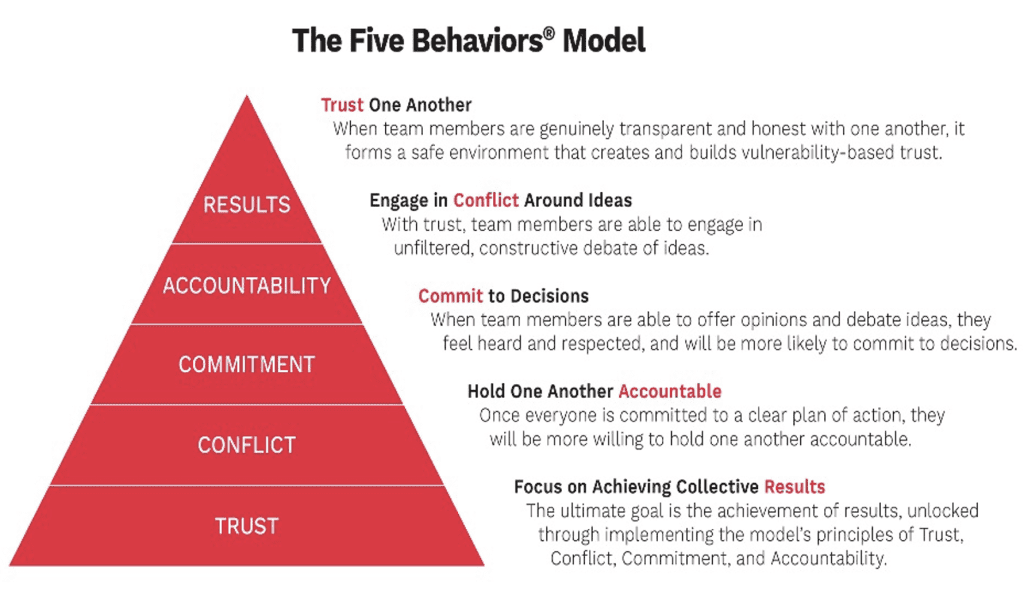The Five Behaviors of a Cohesive Team™ is an outstanding program for organizations who would like to improve, or enhance their effectiveness working as a team. The program is extremely useful for helping teams become productive and high-functioning. What organization would not want that?
The upside of such a team is:
- Making better and quicker decisions
- The ability to tap into the skills and opinions of all team members
- Avoiding time wasters and energy on things like politics, confusion, and destructive behaviour
- Avoiding time spent talking about the wrong issues and revisiting the same topics due to a lack of buy-in
- Creating a competitive advantage
- More fun to be a part of the team!
We are all part of a team; even two people can be on a team. By definition, however, a team is a relatively small number of people (three to twelve) who meet on a regular basis and are collectively responsible for results. Team members should share common goals, and the rewards and responsibilities for achieving them.
Creating a strong team is an important step toward culture. Cultures that are optimistic and effective also have a strong sense of team. Working together for the benefit of the organization’s goals and accomplishments, versus individual accomplishments, aptly describes what a team is all about.
Having the skills and confidence to be candid, albeit respectful, with one another is also an important attribute of a strong team. This is learned, however, and is not typically assumed in an organization.

Organizational culture that is positive, collaborative, and cohesive promotes teamwork through an ongoing, conscious effort. A collection of individuals makes the choice to actively follow The Five Behaviours®, and continue to practice and check in regarding their collective efforts and results. Like anything else, a cultural transformation does not happen overnight, nor does it happen by chance.
Without trust, there is no teamwork. But specifically, what does trust mean? Trust is confidence among teams that intentions are good, that competition does not exist, and most importantly (and often with difficulty), teams must become comfortable being vulnerable with each other. It should be okay, and without retribution, to admit mistakes.
There is often a fear of conflict, or conflict is viewed as a negative emotion. Conflict does not have to mean fighting or attacking one another but rather being productive and putting feelings aside to find a collective solution. Teams also need to respect disagreements and if a conversation does get heated, take it “offline” and private. Giving each other permission to debate often opens the door, to be honest.
Learn all about how top build powerful relationships in the workplace here
Commitment on a team creates clarity and buy-in, even if consensus is not achieved. As a matter of fact, consensus is rarely achieved but the willingness to commit to the best decision, even if it requires risktaking, is better than no decision. If team members are not allowed to offer opinions and contribute to a debate, buy-in cannot be achieved.
A culture of accountability must be one that allows and encourages team members to call on their peers on items that can impact the rest of the team. Leadership should lead by example, and also encourage the rest of the team to offer respectful and effective peer pressure for the accomplishment of the goal. Leadership should also encourage their teams to offer feedback up the ladder, and ensure all team members feel they have permission to do so, without consequences.
The ultimate behaviour is results if they are focused on clearly defined objectives and outcomes. Results need clarity and team commitment that is well promoted. Leaders must reserve rewards and recognition for those who contribute to team goals, not those who work as individuals.
The Five Behaviors® Model is simple, yet takes practice. Different personality styles and behaviours will react differently when first learning. Sometimes people are afraid of conflict, or perceived conflict, and of making mistakes. A supportive and vulnerable leader makes the difference and leads by example.
Some common obstacles to achieving cohesive teamwork include:
- Lack of shared rewards
- Lack of drive and urgency
- Insufficient or ineffective processes
- Vague or shifting team goals
- More emphasis on personal versus team goals
- Emphasis on career status
Looking to improve your teams engagement? Click here.
If you find the concept interesting, check out The FIVE Dysfunctions of a TEAM, a leadership fable by Patrick Lencioni. Lencioni developed The Five Behaviors® Model to empower teams to rethink their approach to teamwork and shape new behaviours – taking teams and their organizations to the next level.
We would love to know how you feel your team compares to this model and if you can see the advantages to teamwork and effectiveness by adopting The Five Behaviors®. The training is offered as a one-day or three-day workshop, broken into half days to allow team practice between sessions. That is ideal since some organizations prefer something shorter and more focused, while others see the benefit of delving into the detail.
Considering the changing workplace, and combination of in-person, remote or hybrid versions, teamwork has likely never been more challenged. In addition, the world around us has been full of negative information over the past two years, and the outcome can be demotivated and angry employees. The organizations that prioritize teamwork and recognize the need for a strong culture, are the organizations that will lead the way in their respective industries.
“If you can get all the people in an organization rowing in the same direction, one can dominate any industry, any market, against any competition, at any time”. – Patrick Lencioni.




